Two days were adequate for us to already go through the major tourist spots in Phnom Penh and know about the history behind each. Phnom Penh in Cambodia is a must-visit city noted for its beautiful and historical sites. However, as the nation’s capital, it is not exactly the kind of city you would be to excited to view skyscrapers or be thrilled with modernization, luxurious delight, and the like. At least not for now.
at the Royal Palace
Rather, Phnom Penh is a place that holds proofs and records on the torture and deaths viciously done by the Khmer Rouge led by Pol Pot. I was surprised to hear how the Khmer Rouge and its leaders could be so evil to their fellow Cambodians. Our tourist guide narrated about the random deaths and mutilation inflicted on millions of civilians and how they were forced to evacuate the city during their civil war in 1975. More on the story below.
From Ho Chi Minh, Vietnam, we boarded a direct bus to Phnom Penh, Cambodia and listened to podcasts during the six-hour transit. (Click here to know more about how to go to Cambodia from Vietnam.) Bus fare was only USD 10 but cost was already included in our travel package as arranged by Transpipol Travel and Tours. Upon arrival at Phnom Penh, Rith, our English-speaking tourist guide took us to a Chinese buffet restaurant and immediately drove us to the tour destinations as in the itinerary.

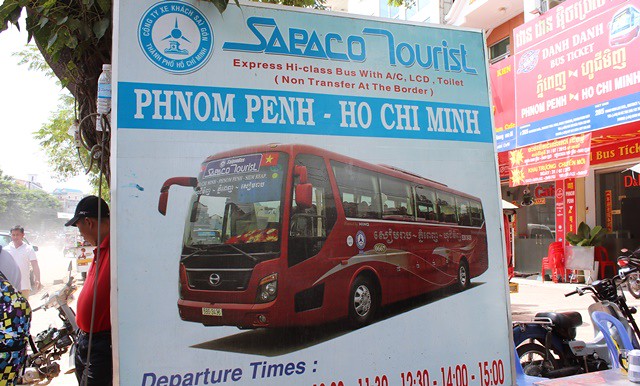
Travel Guide: Top 7 Tourist Attractions We Visited in Phnom Penh, Cambodia
1. Killing Fields (Choeung Ek Memorial)
Our first stop was the Killing Fields (Choeung Ek Memorial). I did not realize that the story Rith was telling us about during the drive from the restaurant would be related to this “execution ground” until we saw the actual site. The reason why it’s called “Killing Fields” is that from its literal name, this area was turned into a mass grave by the Khmer Rouge during their four-year reign of terror in Cambodia (1975 to 1979). Once an orchard and a Chinese graveyard, this memorial can evoke haunting yet powerful feelings to visitors.
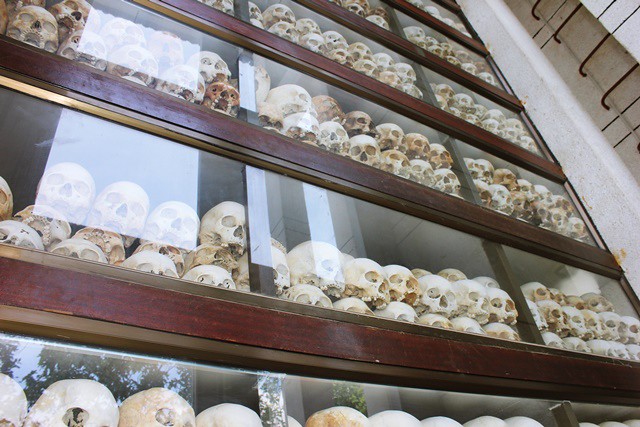

It was easy to paint a picture of the killings in my head because the skulls, bones, and remnants of the regime’s victims were all still there! We entered the Buddhist stupa and found over eight thousand human skills with color-coded stickers that reveal how the person died (according to the type of tool or weapon used on them). Visitors are required to put shoes off. Giving of flowers is optional as a sign of respect.

We then continued to the mass graves which contain thousands of dead bodies discovered at Choeung Ek after the fall of the Khmer Rouge regime. 🙁 This was where brutal executions of more than 17,000 men, women, and children were done. I could not imagine what was going on the Khmer Rouge’s mind at that time. They’re crazy. On the mass graves, lying beneath those sands were bones. We even saw teeth. Eeeep! 🙁

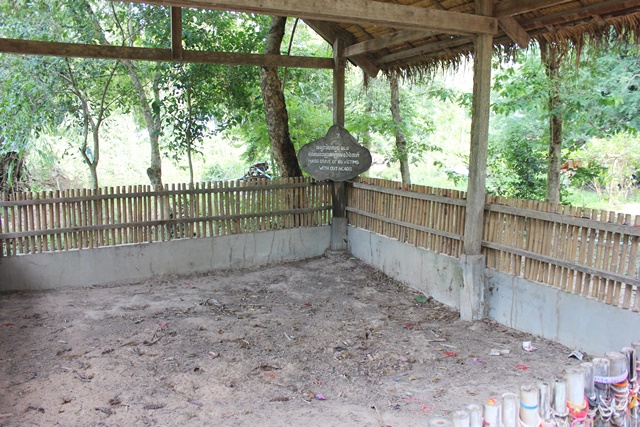
Operating Hours: 7:30AM – 5:30PM
Entrance Fee: $6
2. Tuol Sleng Genocide Museum (S-21 Prison)
To continue our “historical tour,” we went to Tuol Sleng Genocide Museum (S-21 Prison) which was a high school converted to a bloody persecution center, prison, and interrogation facility. There’s over a hundred persecution centers scattered in Cambodia, but this is the largest one.
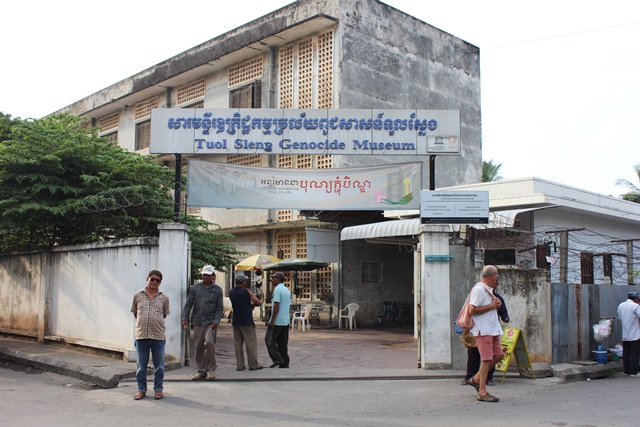
In the past, everyone regardless of position, rank, and class in the society were forced to live in the provinces and pursue agriculture/farming. The Khmer Rouge detested the rich and the educated since these might be serving as “agents” or “spies” that reach out for help from other countries. Hence, to put everyone in the test, the Khmer Rouge asked skilled workers, teachers, and professionals in the provinces if they want to volunteer to work for the government and move back to the city—only to further pin down the rich and educated and torture them to death.
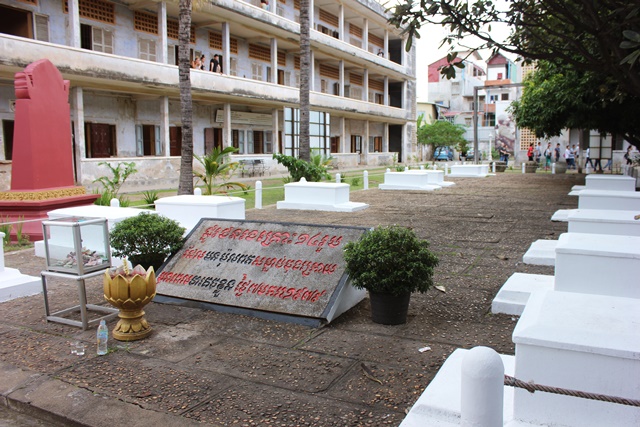
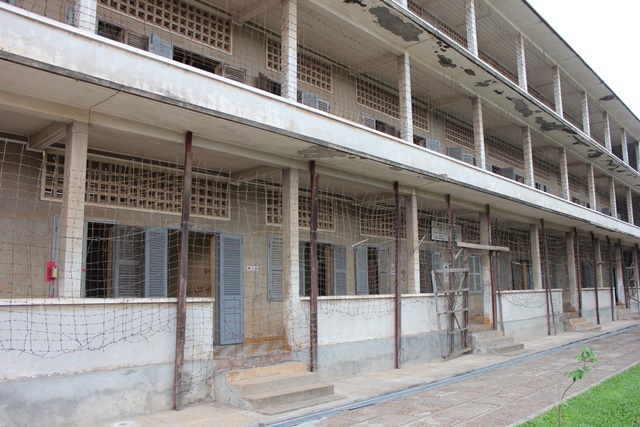
These people were sent to Tuol Sleng where they were treated as inmates. They were tortured to confess what they know and eventually put to the Killing Fields of Choeung Ek to be executed. From over 17,000 people, only seven survived. One of them was present during our visit, and I was lucky to take a picture of him. Read his testimony published by Phnom Penh Post here.

The Tuol Sleng Genocide Museum today has four buildings which serve as living testaments to the madness of the Khmer Rouge regime. Photos and stories of the victims are displayed in a gallery format. Rooms, cubicles, and walkways all looked scary. Smiling, laughing, and making loud noises are prohibited. It’s really hard to even crack a smile when you’re there.
Operating hours: 8:00AM – 5:00PM daily, closed for lunch
Entrance fee: $3
3. Royal Palace
On our second day in Phnom Penh, we relaxed a bit and toured the less traumatic places in the city. Visiting the Royal Palace was originally in our itinerary for Day 1. However, since it’s only open from 8:00 AM to 5:00 PM, and we arrived at about 4:00 PM, Rith suggested to move it to the next day. It was actually a wise idea, so our pictures would also come out more vivid with better natural outdoor lighting. 🙂
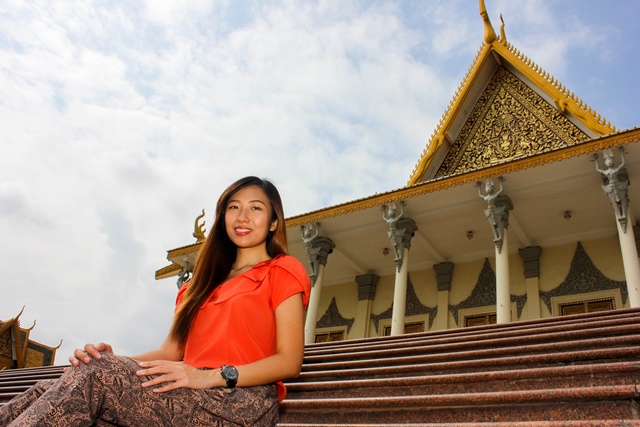
The Royal Palace of Cambodia is where their king officially resides and holds meetings. Some buildings cannot be entered but we were already satisfied to visit and walk around in the compound. The buildings with beautiful towering golden spires are a great example of classic Khmer architecture in Cambodia. Surrounding the buildings were statues, stupas, and beautifully landscaped gardens.
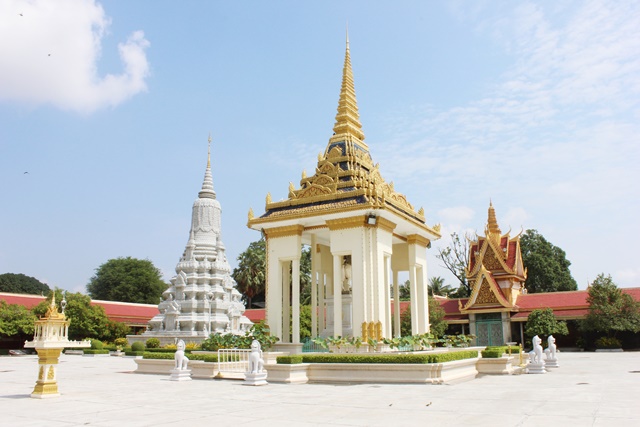


Operating hours: 8AM-11AM, 2PM-5PM
Entrance fee: $3
4. Silver Pagoda
Within the same vicinity as the Royal Palace, the Silver Pagoda (formally known as Preah Vihear Preah Keo Morakot) houses many national treasures such as gold and jeweled Buddha statues that are gifted to the king from different countries. It’s called “Silver” Pagoda because the entire flooring is made of silver. More than 5300 pieces of 1.125 kilo silver tiles are used to cover the floor, and the silver pieces collectively weigh over six tons.
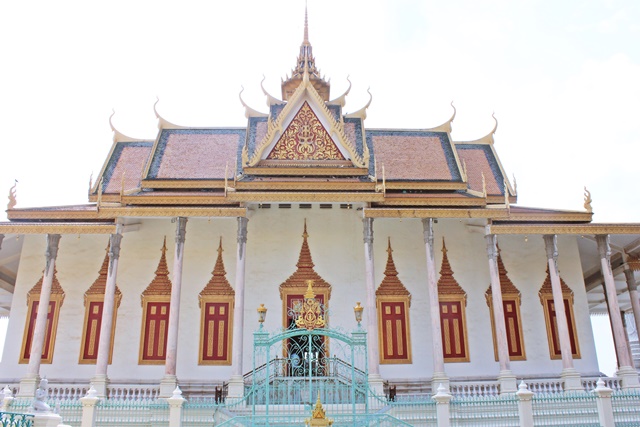
However, we could not see the silver tiles clearly because they are covered with carpet to prevent damage as it’s open for public viewing. Another special thing to be amazed about the Silver Pagoda is the life-sized gold Maitreya Buddha decorated with 9584 diamonds.
5. Wat Phnom
Wat Phnom is a sacred shrine on top of a hill where many locals find time to pray. It’s interesting to learn that this was essentially where “Phnom Penh” got its name. “Phnom” translates to “hill” in English, and “Penh” was the name of the lady who found four Buddha statues inside the hollow of a large koki tree trunk from the river.
Image of Penh
She intended to use the trunk to build a house. Wat Phnom’s location now was a section of her property, and she decided to keep the four Buddha statues in a small shrine for people to worship.
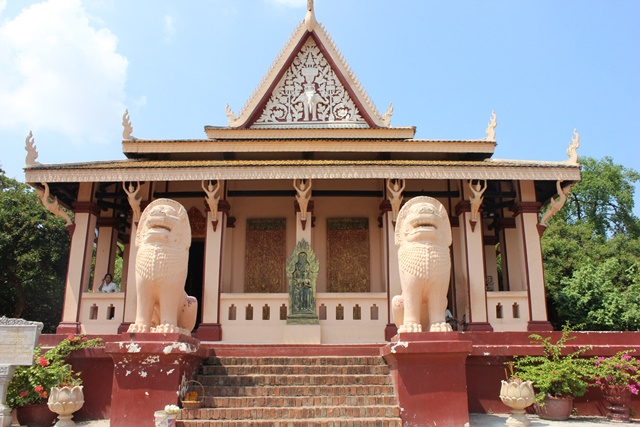
There’s a fortune teller in the shrine who’s known to tell bad news about romantic relationships of couples asking about their future. I don’t know if it’s true but since Penh was a widower, she might not want couples to be happy and stay together long.
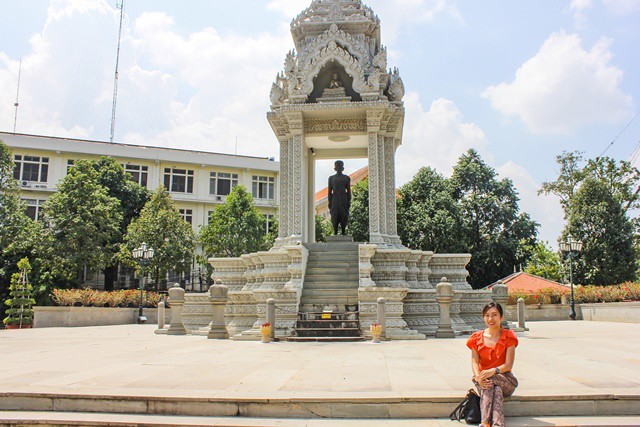
6. Phsar Thmey (Central Market)
After lunch at Sorya Restaurant, we walked to Phsar Thmey which means “New Market” in the Khmer language. It’s a market that sells all sorts of things from raw food (meat, fish, vegetables, local delicacies, and snacks), cooked food (hawker-style eateries), to non-food items like clothes, footwear, bags, watches, accessories, etc. and most of them are Class A version or replica of branded/designer goods.
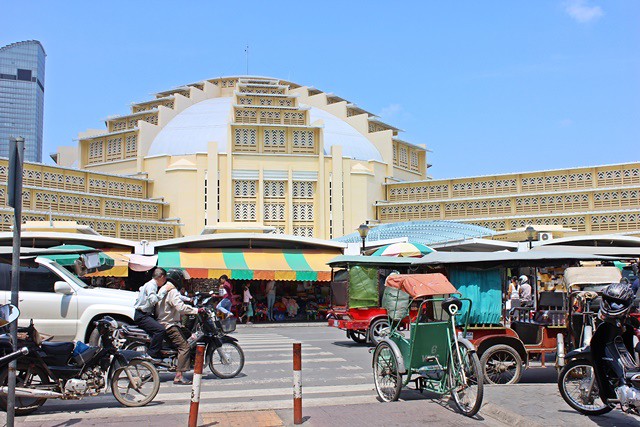
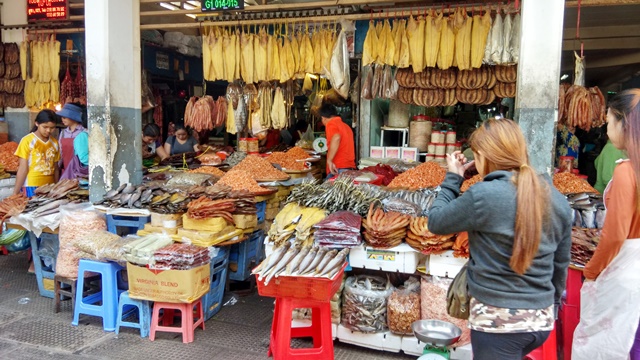
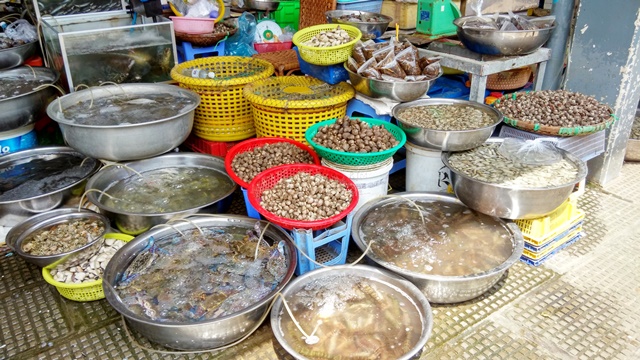
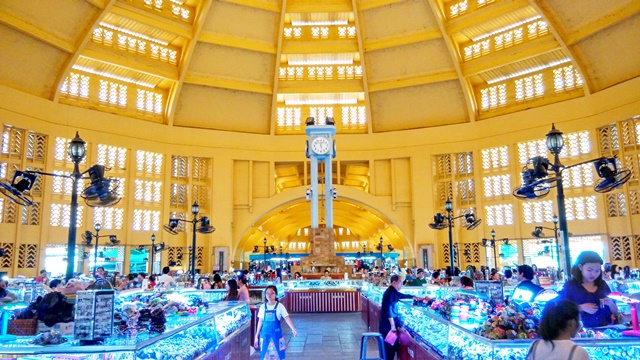
7. Sorya Shopping Centre
Our shopping continued at Sorya Shopping Center nearby. It was the largest shopping center in Phnom Penh until the opening of the Aeon Mall in Phnom Penh. and we said goodbye to Rith before the driver drove us back to our hotel.
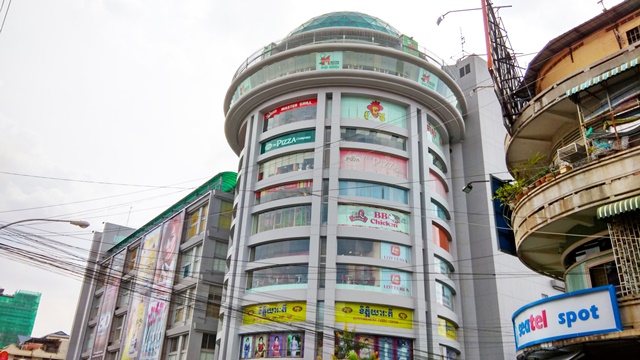
Sorya Shopping Centre was the first shopping mall to have ever opened in Phnom Penh in 2003 and the largest shopping center until Aeon Mall opened in the year after. It was a sensational mall among the locals that time as they had never seen escalators before. Prices of goods here are more expensive than those in the Central Market. Filled with tiangges (flea market style), it’s more like Tutuban, 888 Meisic Mall, or 999 Mall in Manila.
last pic with Rith before we parted ways
Wrap Up
I never thought that there could be people as cruel or even more cruel than the Nazis led by Hitler who killed six million Jews. What Pol Pot’s Khmer Rouge did to the Cambodians was among one of the most calamitous legacies of the 21st century. The guy was a monster, having killed 25% of the entire population of Cambodia.
The worst thing is that many Cambodians have been negatively affected, and many have lost their loved ones to the agonizing war of the “agrarian economy.” This happened only 40 years ago, so reconstruction of the country and stability of the government are not yet fully in place.
We may still have to wait for a decade or two to see real progress. For now, it was good to have come around Phnom Penh as it gave us a heightened sense of cultural awareness and the opportunity to explore a different side of Cambodia apart from the famous Angkor Wat in Siem Reap. 🙂
Up next: Review of Rose Emerald Hotel in Phnom Penh and the Top Tourist Attractions We Visited in Siem Reap, Cambodia

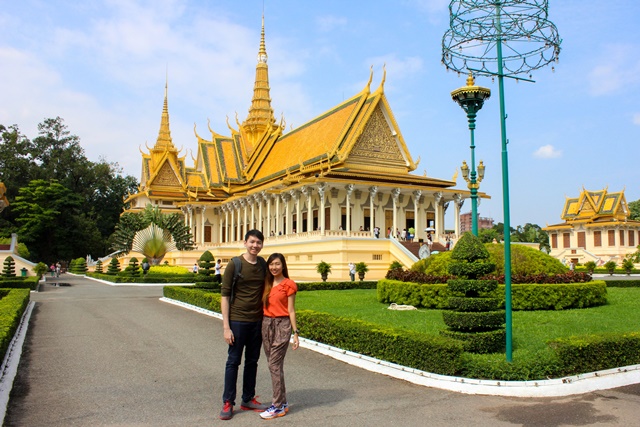
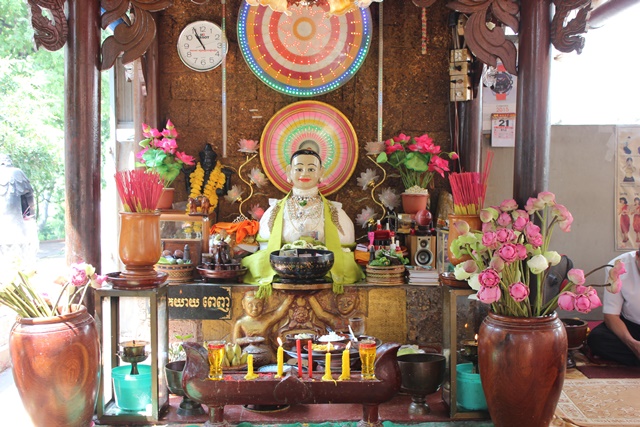

Leave a Reply to Michelle Cancel reply